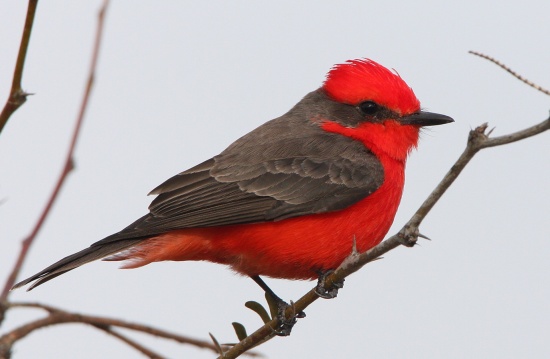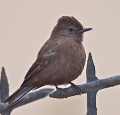m |
(move extra photos to gallery) |
||
| Line 6: | Line 6: | ||
'''Male''': Bright red underparts and cap, dark brownish wings, tail and mask.<br /> | '''Male''': Bright red underparts and cap, dark brownish wings, tail and mask.<br /> | ||
'''Female''': Dull brownish or greyish upperparts, dark streaked whitish underparts | '''Female''': Dull brownish or greyish upperparts, dark streaked whitish underparts | ||
| − | |||
| − | |||
| − | |||
Some subspecies have pinkish or yellow flanks and/or crissum | Some subspecies have pinkish or yellow flanks and/or crissum | ||
| Line 17: | Line 14: | ||
Both sexes of race ''obscurus'' (from coastal Peru) also occur in a uniformly dark brown morph. | Both sexes of race ''obscurus'' (from coastal Peru) also occur in a uniformly dark brown morph. | ||
| − | + | ||
====Similar Species==== | ====Similar Species==== | ||
| − | Females and immatures are potentially confusing, but can be separated from most other superficially similar species (e.g. [[Bran-colored Flycatcher]]) by the faint or complete lack of wing-bars. | + | Females and immatures are potentially confusing, but can be separated from most other superficially similar species (e.g. [[Bran-colored Flycatcher]]) by the faint or complete lack of wing-bars. The female can be confused with [[Say's Phoebe]], but is smaller, and has a much smaller bill. |
| + | |||
| + | <gallery> | ||
| + | Image:d11_1978.jpg|'''Female'''. Photo by {{user|Gary+Clark|Gary Clark}}<br />Location: El Charco del Ingenio, San Miguel de Allende, [[Mexico]] | ||
| + | Image:Juvenile Vermilion Flycatcher.jpg|'''Juvenile'''<br />Photo by {{user|bobsofpa|bobsofpa}}<br /> [[Big Bend National Park]], [[Texas]], [[USA]]. | ||
| + | Image:Vermillion Flycatcher melanistic.jpg|'''Dark morph'''<br />Photo by {{user|Stanley+Jones|Stanley Jones}}<br /> Lima, [[Peru]], September, 2009 | ||
| + | </gallery> | ||
| + | |||
==Distribution== | ==Distribution== | ||
| − | |||
Widespread and generally common in most of central and northern [[South America]], [[Central America]], [[Mexico]] and southwestern [[United States]]. | Widespread and generally common in most of central and northern [[South America]], [[Central America]], [[Mexico]] and southwestern [[United States]]. | ||
| Line 43: | Line 46: | ||
*P. r. nanus'': [[Galapagos Islands]] (except Chatham Island) | *P. r. nanus'': [[Galapagos Islands]] (except Chatham Island) | ||
*P. r. dubius'': [[Chatham Island]] (Galapagos Islands) | *P. r. dubius'': [[Chatham Island]] (Galapagos Islands) | ||
| − | |||
It has been suggested that the two Galápagos races, ''nanus'' and ''dubius'', should be considered one or two separate species. | It has been suggested that the two Galápagos races, ''nanus'' and ''dubius'', should be considered one or two separate species. | ||
Revision as of 18:08, 4 February 2012
- Pyrocephalus rubinus
Identification
L. 14 cm (5½ in)
Strongly sexually dimorphic. Male is unmistakable.
Male: Bright red underparts and cap, dark brownish wings, tail and mask.
Female: Dull brownish or greyish upperparts, dark streaked whitish underparts
Some subspecies have pinkish or yellow flanks and/or crissum
Immature: Resembles female
Subspecies: Females from Galápagos have virtually unstreaked, yellow underparts.
Both sexes of race obscurus (from coastal Peru) also occur in a uniformly dark brown morph.
Similar Species
Females and immatures are potentially confusing, but can be separated from most other superficially similar species (e.g. Bran-colored Flycatcher) by the faint or complete lack of wing-bars. The female can be confused with Say's Phoebe, but is smaller, and has a much smaller bill.
Female. Photo by Gary Clark
Location: El Charco del Ingenio, San Miguel de Allende, MexicoJuvenile
Photo by bobsofpa
Big Bend National Park, Texas, USA.Dark morph
Photo by Stanley Jones
Lima, Peru, September, 2009
Distribution
Widespread and generally common in most of central and northern South America, Central America, Mexico and southwestern United States.
Typically resident, but a large proportion of the population from the southernmost part of its range migrates north to spend the Austral winter in central South America. Additionally, most of the population in USA migrate south to spend the winter in Central America.
Taxonomy
Subspecies[1]
Around 13 subspecies are generally recognised:
Rubinus Group
- P. r. flammeus: Arid south-western US to Baja California and north-western Mexico (Nayarit)
- P. r. mexicanus: Arid south-western Texas to Guerrero, Oaxaca, Puebla and Veracruz
- P. r. blatteus: South-eastern Mexico (southern Veracruz) to Guatemala and Honduras
- P. r. pinicola: Lowland pine savanna of north-eastern Nicaragua
- P. r. saturatus: North-eastern Colombia to northern Venezuela, Guyana and northern Brazil
- P. r. piurae: Colombia (west of Eastern Andes) to westelrn Ecuador and north-western Peru
- P. r. ardens: Northern Peru (Cajamarca, Amazonas and extreme eastern Piura)
- P. r. obscurus: Western Peru (Lima)
- P. r. cocachacrae: South-western Peru (Ica to Tacna) and adjacent northern Chile
- P. r. major: South-eastern Peru (Cuzco and Puno)
- P. r. rubinus: Extreme south-eastern Brazil to south-eastern Bolivia, Paraguay, Uruguay, north-eastern Argentina
Galapagos Group
- P. r. nanus: Galapagos Islands (except Chatham Island)
- P. r. dubius: Chatham Island (Galapagos Islands)
It has been suggested that the two Galápagos races, nanus and dubius, should be considered one or two separate species.
Habitat
Occurs in a wide range of open or semi-open habitats, including savanna, forest-edge, woodland, scrub, areas with scattered trees. Also in rural zones and city parks or gardens.
Behaviour
Diet
Feeds on small insects and spiders. It perches on an open branch, waiting for the prey. After locating it, the flycatcher pursues and captures it in flight.
Breeding
The courtship display of the male involves singing, raising its crest, fluffing its breast-feathers and, sometimes, delivering a butterfly or showy insect to the female to initiate copulation.
Breeding is seasonal, but timing varies depending on region. The nest is an open cup loosely constructed by moss, grass, twigs and spiderwebs. The 2-3 eggs are incubated entirely by the female, but both sexes feed the chicks.
References
- Clements, JF. 2009. The Clements Checklist of Birds of the World. 6th ed., with updates to December 2009. Ithaca: Cornell Univ. Press. ISBN 978-0801445019.
Recommended Citation
- BirdForum Opus contributors. (2024) Vermilion Flycatcher. In: BirdForum, the forum for wild birds and birding. Retrieved 4 June 2024 from https://www.birdforum.net/opus/Vermilion_Flycatcher







